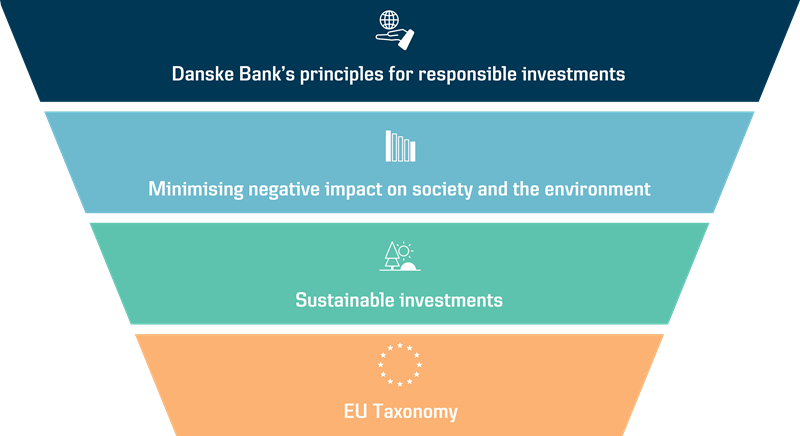When you invest, there are two ways you can focus on sustainability – and the one does not exclude the other:
- focus on minimising negative impact on society and the environment
- focus on contributing to a positive sustainable development of society and the environment
When we know what you want and what you prioritise when it comes to sustainability, we can accommodate your preferences as accurately as possible. That is why we will ask you about your sustainability preferences at an investment meeting. You can read more about the different sustainable investment categories below, and you can also read about Danske Bank’s principles for responsible investment here

Focus on minimising negative impact on society
At Danske Bank, we are working hard to minimise any negative impact on society and the environment that your investments may have. Among other things, this means that the majority of our products do not invest in companies involved with
- coal
- tar sand
- peat
- controversial weapons (such as chemical weapons)
- tobacco
Nor do we invest in companies that contravene international norms and conventions.
In addition, several of our products also focus on encouraging the companies you invest in to move in a more sustainable direction, and we also vote at the annual general meetings of these companies. In this way, you exercise active ownership and help to reduce negative impact on the environment.
Sustainable investments
Investments can also contribute positively to environmental and societal goals by channelling funds towards companies that support such goals. These types of investments are called ‘sustainable investments’. For sustainable investments, it is a requirement that the investment does not have a significant impact on other sustainability goals.
A sustainable investment can be investment in companies that contribute to the green transition. Such contributions include finding solutions that promote biodiversity, the circular economy, reduction of CO2, improved working conditions, social integration or that contribute to other UN environmental or social goals.
A sustainable investment can also be an investment in companies that are transforming their business models to support the green transition. In other words, investment in companies that may not necessarily be climate friendly or socially responsible today, but which are working on these issues and are moving in the right direction.
The EU Taxonomy
Sustainable investments that contribute to an environmental objective can also meet the standards set out in the EU Taxonomy. The EU Taxonomy is a classification of activities that contribute positively to the EU’s environmental objectives and can be recognised as ‘environmentally sustainable’. The six EU environmental objectives are
- Climate change mitigation
- Climate change adaptation
- Sustainable use and protection of water and marine resources
- Transition to a circular economy
- Pollution prevention and control
- Protection and restoration of biodiversity and ecosystems
Currently, the EU Taxonomy covers only the area of climate and not, for example, socially sustainable activities. The Taxonomy is being continually developed, and over the coming years it will be updated with additional criteria covering more activities for all of the Taxonomy’s environmental objectives.
Now you have had a brief introduction to the categories we are working with in the area of responsible investments. Remember that one does not exclude the other.

